Welcome to another post of my strange animals series where you get to meet some of weirdest, coolest, and craziest animals on a daily basis!
Today I want to show you one of the most beautiful, colorful and weird-looking caterpillars you are likely to ever encounter! Scientifically described as Parasa indetermina, the butterfly stage of this species is commonly known as the Stinging Rose Moth. But why is it so colorful? And why is called "stinging"?
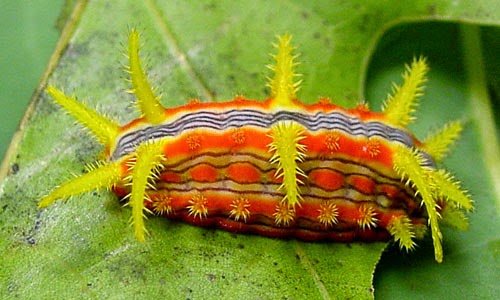
Stinging Rose Moth Caterpillar: Simply amazing!
Let's find out!
What's with all the colors?
By now you may be thinking.. Why the heck are these caterpillars so colorful? Before answering this question, let me say that these little guys pack quite the sting! Their body is covered by pairs of long, horn-like, bristly spines and clumps of smaller spines that have poisonous glands at their base.
When touched, the spines break off and release venom to the victim's skin. To humans, the sting is not lethal but usually causes a very painful rash. So, that's why it's called "stinging". You can look, but you can't touch!

Illustration of the spines. Credit:Dyar, H. G. 1897. Life-histories of the New York slug caterpillars
As for the vivid colors, they are a form of aposematism. Aposematism is "an anti-predator adaptation in which a warning signal is associated with the unprofitability of a prey item to potential predators". [7]
In simple words, it's the exact opposite of camouflage. Essentially, the caterpillar says, "Look here I am, feel free to eat me..if you want to die or something!"

Where can I find one?
If you want to see on from up close then you can search for them in the forests of North America. The species occurs anywhere, from New York to Florida, west to Missouri and Texas. I wish you good luck though.. Despite the widespread distribution, sightings are extremely rare! The sixth link in the references has some good tips if you want to try your luck!
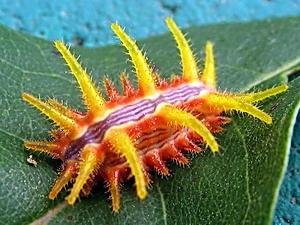
How big does it get?
The size of fully grown caterpillars ranges from 3/4 to 7/8 inches. As for the butterfly stage, it has a wingspan of about 2.0 to 2.5 cm (.75 - 1.0 inch).
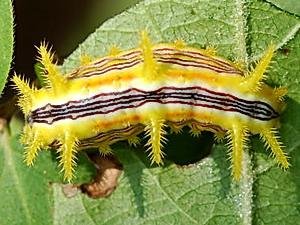
What does it eat?
The caterpillar consumes the foliage of numerous plants, including but not limited to:
- Apple
- Bayberry
- Cherry and plum
- Chestnut
- Cottonwood
- Dogwood
- Hickory
- Maple
- Oaks
- Redbud
- Sycamore
Butterflies have rudimentary mouthparts and apparently don't eat anything until the day they die.
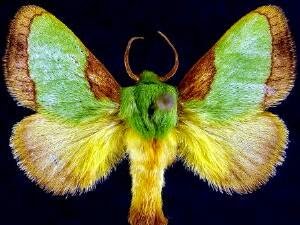
The butterfly stage has certainly lost much of its charm!
What's their life like?
Like all other Lepidoptera (butterflies and moths), the stinging rose caterpillar goes through four distinct developmental stages: egg, larva, pupa and adult, with a single brood produced each year.
Butterflies make their appearance early in the summer and females lay their eggs on stems or leaves in July. It takes about 9-10 days for the eggs to hatch and the larvae tends to hide and feed on the undersides of leaves. They start to mature around mid-September and they winter as pupa until summer when they emerge as butterflies to continue the cycle.
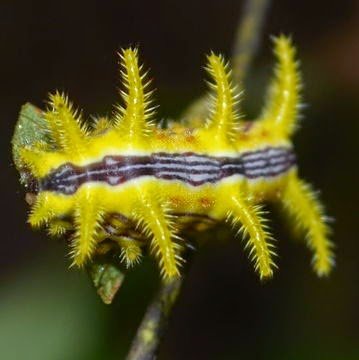
Credit: James Shelton
Is the species threatened?
The stinging rose caterpillar has always been reported as a very rare sighting, however, it doesn't appear to be immediately threatened due to its wide distribution. While some human-related threats (habitat loss) have apparently put a lot of pressure in some local populations, the species appears to be secure in much of its range. [8,9]
Video of a stinging rose moth
The End
That's pretty much for today! I know, the article was smaller than usual but there isn't much else interesting about the species. Hope you enjoyed the photography as much as I did! See you tomorrow, in the next strange animal post!

Photo Credit
All uncredited photos are from the Mississippi State University. Click here for more information
References
- Uark.edu
- Acris.nynhp.org
- Enpp.auburn.edu
- Bugguide.net
- Mothphotographersgroup.msstate.edu
- Fs.usda.gov
- Wikipedia.org
- Explorer.natureserve.org/
- Acris.nynhp.org

My dear readers, thank you for reading today's article. Hopefully, you found it interesting enough to follow me, @trumpman, for more weird and bizarre creatures from all around the word! If you like strange animals as much as I do, here are the last 3 weirdos of this series:
- Pacific Barreleye: Meet the Fish With the Transparent Head!
- Phrynosoma Hernandesi: Meet the Lizard That Shoots Blood From Its Eyes!
- Sea Pigs: Adorable, Alien-Like, Deep-Sea Creatures
Steemstem & Steemit Education
Interested in science? Please, don't forget to check the @steemstem project, a community-driven project meant to promote well-written, high-quality, STEM-related content (STEM as for Science, Technology, Engineering and Mathematics). Just click here to join us! And for those engaging with education, @steemiteducation is here to join all steemian educators in their common cause of making the job easier, more effective and more fun!

